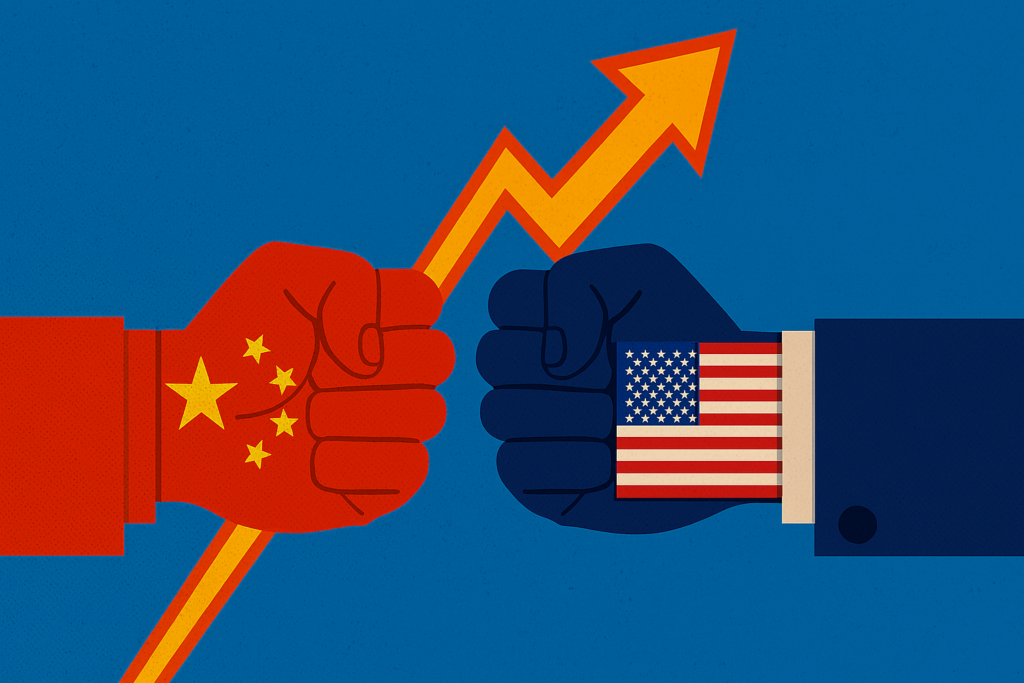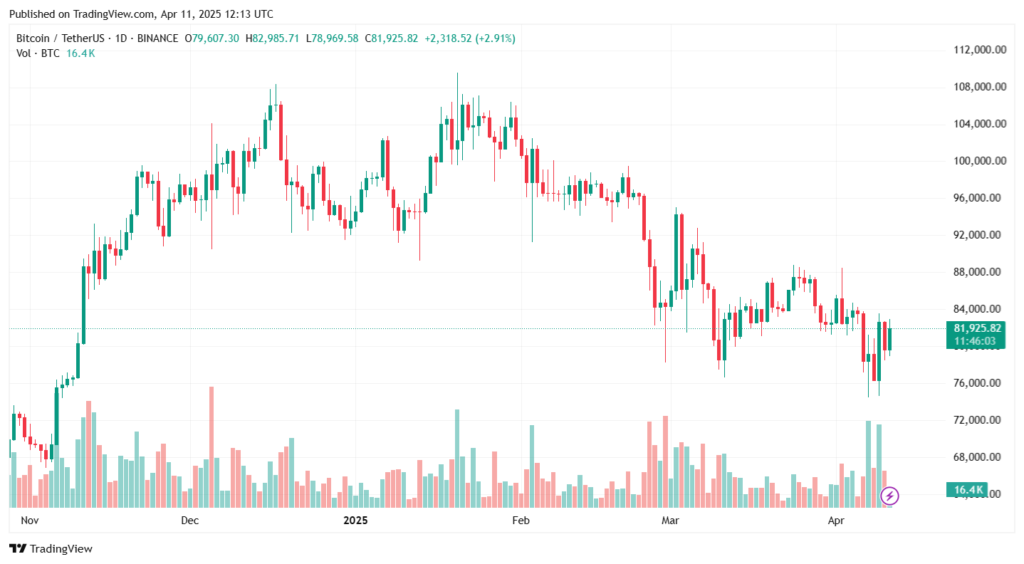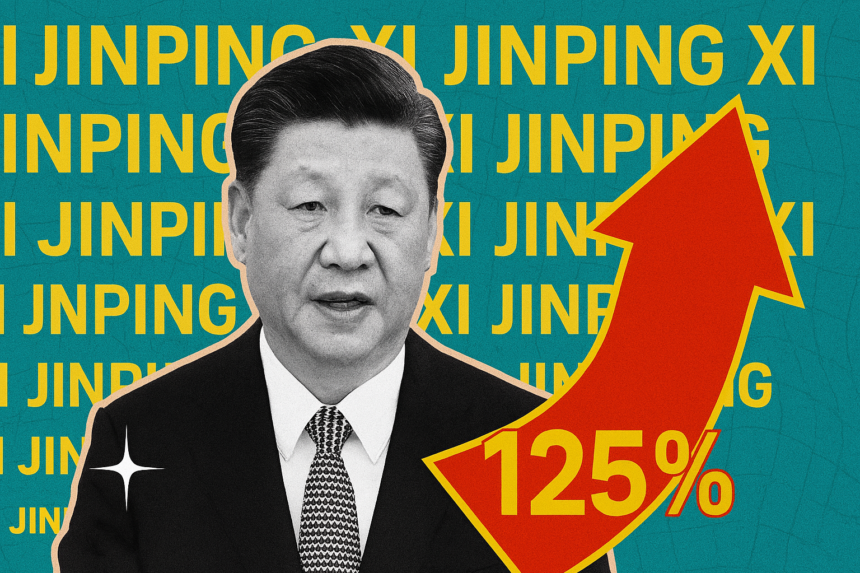– Ad –
| Getting your Trinity Audio player ready... |
In a dramatic escalation of economic tensions, China raised tariffs on U.S. goods to 125% on April 11, 2025, igniting fresh concerns of a prolonged trade war between the world’s two largest economies. The move, a direct retaliation against Washington’s earlier decision to raise tariffs on Chinese imports to 145%, has already rattled global stock markets, disrupted investor sentiment, and spurred fears of a global economic downturn.
Despite this geopolitical tremor, one sector remained notably resilient: the cryptocurrency market. In contrast to the volatility witnessed in equities and commodities, Bitcoin, Ethereum, and other digital assets largely held their ground, underscoring the growing perception of crypto as a hedge against traditional market turbulence.
What Prompted China’s Aggressive Tariff Hike?
The seeds of this latest trade war escalation were sown in early April, when the United States, under President Biden’s administration, introduced a 145% tariff on critical Chinese exports — including electric cars, computer chips, solar energy equipment, and healthcare devices. The move was part of a broader push to re-shore manufacturing and protect domestic industries in the lead-up to the 2024 U.S. elections.
China’s response was swift and calculated. The Ministry of Finance announced that starting immediately, over 500 categories of American products — from agricultural commodities to technological components — would face a 125% import tax.
In a press statement, Chinese officials warned:
“There is no market acceptance for U.S. goods at the current tariff level. If the U.S. continues down this road, the economic consequences will be meaningless and mutually destructive.”
Trade War Intensifies
The Chinese Ministry of Finance stated that the new tariffs would take effect immediately, emphasizing that the current level of tariffs effectively eliminates the market acceptance of U.S. goods in China. The Ministry also indicated that further U.S. tariff increases would be economically meaningless and historically misguided.

This development follows the U.S. decision to exclude China from a 90-days tariff pause, prompting Beijing’s retaliatory measures. The tit-for-tat tariff increases have raised concerns about the potential for a prolonged trade war and its impact on the global economy.
Global Market Reactions
The announcement has led to heightened volatility in global financial markets. U.S. stock indexes have fallen 6-7% since the tariff announcements, while gold prices have reached record highs due to geopolitical and economic uncertainties. Currency markets are also turbulent, with the U.S. dollar experiencing its steepest weekly decline since 2022.
Cryptocurrency Market Shows Resilience
Despite the turmoil in traditional financial markets, the cryptocurrency market has demonstrated notable resilience. As of today:
- Bitcoin (BTC) is trading at approximately $82,175, showing a modest increase of 0.44% from the previous close. The intraday high reached $82,763, with a low of $78,626.
- Ethereum (ETH) is trading at around $1,561.22, experiencing a slight decrease of 1.84% from the previous close. The intraday high was $1,604.46, and the low was $1,486.37.
The relative stability of cryptocurrencies amidst escalating trade tensions highlights their emerging role as alternative assets during periods of economic uncertainty.

Why Crypto Remained Resilient
This isn’t the first time crypto has acted as a non-correlated asset, but this instance solidified a few important themes:
1. Decentralization = Detachment from Traditional Finance
Crypto operates on decentralized blockchains, not through government-backed systems. While fiat currencies and equities are heavily influenced by trade policies and central bank moves, crypto continues functioning independently, making it less vulnerable to political shocks.
2. Digital Assets as Inflation Hedges
As governments turn to tariffs and stimulus to protect domestic economies, investors grow concerned about currency devaluation and rising inflation. Bitcoin, limited to a maximum supply of 21 million, is increasingly viewed as a store of value, similar to digital gold.
3. Institutional Support & Maturity
In 2024–25, institutional players like BlackRock, Fidelity, ARK Invest, and even sovereign wealth funds increased their allocation to crypto. This capital cushion adds liquidity and stability during moments of macro uncertainty.
4. 24/7 Liquidity
Unlike stock markets that shut overnight or during holidays, crypto trades 24/7, allowing investors to respond instantly to global events — a major advantage during crisis windows.
Impact on U.S. and Chinese Economies
United States
- Farmers and exporters could suffer as their products become less competitive in the Chinese market.
- Consumer electronics and automobiles may see price hikes, with analysts warning of a potential doubling in iPhone prices due to rising component costs.
- The tariff war may strain supply chains, especially for EVs and chips, affecting manufacturing timelines and product rollouts.
China
- As a manufacturing powerhouse, China’s exports could face diminished demand in the U.S., especially in tech and green energy.
- However, it may strengthen ties with non-Western economies, boosting trade with BRICS nations, the Middle East, and Southeast Asia.
What This Means for Investors
If you’re actively managing a portfolio, here are a few key takeaways:
- Rebalance with Uncorrelated Assets – Crypto’s resilience makes it a worthy addition to hedge against geopolitical instability.
- Watch for More Volatility – Further escalations in tariffs, or retaliatory sanctions, could trigger additional swings in both traditional and digital asset markets.
- Look Beyond Headlines – As central banks and regulators step in to stabilize markets, there may be short-term relief rallies, but long-term effects could still play out through inflation and policy shifts.
Reactions from the Global Community
The geopolitical ripple effect has been immediate:
- The EU called for de-escalation and dialogue between the U.S. and China to avoid collateral damage to global trade.
- India and Japan urged stability, given their reliance on both U.S. and Chinese supply chains.
- The WTO received an official complaint from China, accusing the U.S. of violating international trade agreements.
Meanwhile, U.S. trade representatives hinted that backdoor negotiations are ongoing, but no breakthrough appears imminent.
Conclusion: A New Era of Global Finance?
The 125% tariff hike by China, and the U.S.’s preceding 145% move, marks the most serious escalation in trade tensions since the original U.S.–China tariff war under President Trump.
But while stock markets crash, and traditional investors scramble, the crypto market has proven its staying power. It’s no longer just a speculative asset class — it’s a hedge, a haven, and a tool for financial sovereignty in an increasingly polarized world.
The next few months will be crucial. Investors should stay informed, diversified, and open to a future where digital assets play an increasingly central role in global finance.

















